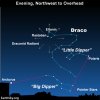In 2013, watch for the Draconid meteor shower on the evenings of October 7 and 8, starting at nightfall.
October’s Draconid meteor shower – sometimes called the Giacobinids – radiates from the fiery mouth of the northern constellation Draco the Dragon. Because the radiant is located so far north on the sky’s dome, this shower favors temperate and far-northern latitudes, such as the U.S., Canada, Europe and northern Asia. In 2013, you’ll want to watch for these meteors on the evenings of October 7 and 8, starting at nightfall. This shower had an unusually rich peak in 2011, but meteor rates this year are expected to be back to normal, meaning only a handful of meteors each hour. The Draconid meteor shower has a rich history, which we talk about below. Follow the links below to learn more about the Draconid meteor shower.
Where is the radiant point of the shower, and when should I watch? Unlike most meteor showers, the Draconids are best seen in the evening, instead of before dawn. That’s because the winged Dragon, the shower’s radiant point, flies highest in the sky at nightfall.
These extremely slow-moving Draconid meteors, when traced backward, radiate from the head of Draco the Dragon, near the stars Eltanin and Rastaban. However, you don’t have to locate Draco the Dragon to watch the Draconids, for these meteors fly every which way through the starry sky.
Simply find a dark, open sky away from artificial lights. Plan to spend a few hours lounging comfortably under the stars. Bring along a reclining lawn chair, have your feet point in a general north or northwest direction and look upward. If you don’t know your cardinal directions, just lie down and look upward. Chill, and enjoy! You might see some meteors.

October’s Draconid meteor shower – sometimes called the Giacobinids – radiates from the fiery mouth of the northern constellation Draco the Dragon. Because the radiant is located so far north on the sky’s dome, this shower favors temperate and far-northern latitudes, such as the U.S., Canada, Europe and northern Asia. In 2013, you’ll want to watch for these meteors on the evenings of October 7 and 8, starting at nightfall. This shower had an unusually rich peak in 2011, but meteor rates this year are expected to be back to normal, meaning only a handful of meteors each hour. The Draconid meteor shower has a rich history, which we talk about below. Follow the links below to learn more about the Draconid meteor shower.
Where is the radiant point of the shower, and when should I watch? Unlike most meteor showers, the Draconids are best seen in the evening, instead of before dawn. That’s because the winged Dragon, the shower’s radiant point, flies highest in the sky at nightfall.
These extremely slow-moving Draconid meteors, when traced backward, radiate from the head of Draco the Dragon, near the stars Eltanin and Rastaban. However, you don’t have to locate Draco the Dragon to watch the Draconids, for these meteors fly every which way through the starry sky.
Simply find a dark, open sky away from artificial lights. Plan to spend a few hours lounging comfortably under the stars. Bring along a reclining lawn chair, have your feet point in a general north or northwest direction and look upward. If you don’t know your cardinal directions, just lie down and look upward. Chill, and enjoy! You might see some meteors.

